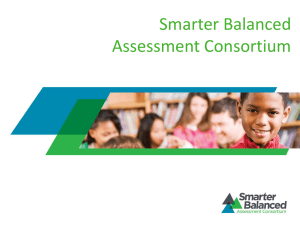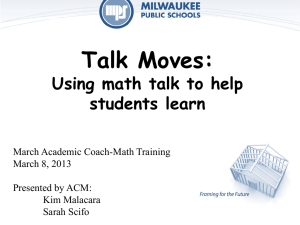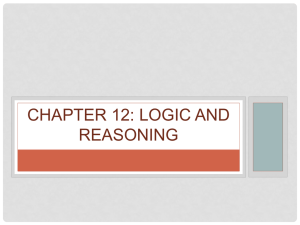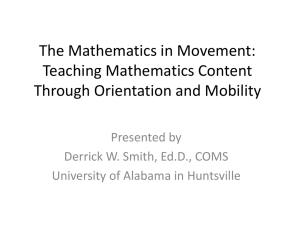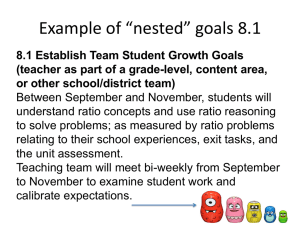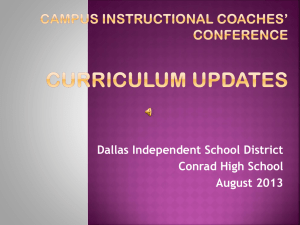NCTM`s High School Curriculum Project:
advertisement
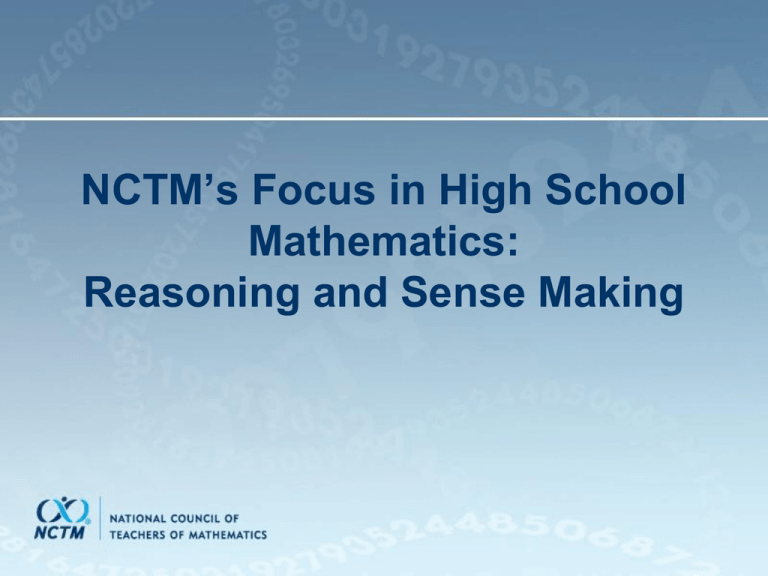
NCTM’s Focus in High School Mathematics: Reasoning and Sense Making History of NCTM’s Standards • 2000 -- Principles and Standards for School Mathematics – Updated the 1989 standards, incorporating the Professional Standards for Teaching Mathematics (1991) and the Evaluation Standards for School Mathematics (1995) • 2006 -- Curriculum Focal Points for Prekindergarten through Grade 8 Mathematics – Set forth the most important mathematical topics for each grade level, based on Principles and Standards But what about high school mathematics? Focus in High School Mathematics: Reasoning and Sense Making • A high school mathematics program based on reasoning and sense making will prepare students for citizenship, for the workplace, and for further study. • Goal: – “To create a document to use as the conceptual framework to guide the development of future publications and tools related to 9-12 mathematics curriculum and instruction.” – Audience -- Everyone involved in decisions regarding high school mathematics programs, including. Definitions • Reasoning – Most generally, the process of drawing conclusions on the basis of evidence or stated assumptions. – Mathematical reasoning ranges from informal explanation and justification to formal deduction, as well as inductive observations. • Sense making – Development of understanding of a situation, context, or concept by connecting it with existing knowledge. Relationship of Reasoning and Sense Making Reasoning Habits • Reasoning and sense making should be a part of the mathematics classroom every day. • Reasoning habit: – “a productive way of thinking that becomes common in the processes of mathematical inquiry and sense making” – Should not be approached as a new list of topics to be added to the curriculum. Reasoning Habits • • • • Analyzing a problem, for example… Implementing a strategy, for example… Seeking and using connections… Reflecting on a solution to a problem, for example… Analyzing a problem • identifying relevant mathematical concepts, procedures, or representations… • defining relevant variables and conditions carefully… • seeking patterns and relationships.. • looking for hidden structure… • considering special cases or simpler analogs; • applying previously learned concepts… • making preliminary deductions and conjectures… • deciding whether a statistical approach is appropriate. Developing Reasoning and Sense Making • Reasoning levels – Empirical – Preformal – Formal • Tips for the classroom, for example: – Provide tasks that require students to figure things out for themselves. – Ask students questions that will press their thinking – for example, “Why does this work?” or “How do you know?” Reasoning in the Curriculum • Reasoning and sense making are integral to the experiences of all students across all areas of the high school mathematics curriculum. • A stance toward learning mathematics, not which will, of course, take time. • However, it also promises compensating efficiencies. – Less reteaching since they may better retain what they have learned. – Focus on underlying connections, less time on lists of skills. Content Strands • Specific content areas in which reasoning and sense making should be developed: – Reasoning with Numbers and Measurements – Reasoning with Algebraic Symbols – Reasoning with Functions – Reasoning with Geometry – Reasoning with Statistics and Probability Key Elements • Provide structure for how each content strand can be focused on reasoning and sense making. • Not intended to be an exhaustive list. • Instead, a lens through which to view the potential of high school programs for promoting and developing mathematical reasoning and sense making. Key Elements for Algebraic Symbols • • • • • Meaningful use of symbols. Mindful manipulation. Reasoned solving. Connecting algebra with geometry. Linking expressions and functions. Example 8 Task (intermediate algebra class) • Find a way of solving the equation x2 + 10x = 144 using an area model. • Teacher: Can anybody see how to think of x2 + 10x as an area? • Student 2: Maybe if we knew what the area of the square was, we could just take the square root to find x. • Teacher: Is there a way of rearranging the figure into a square? • Student 2: But it’s not a complete square. It’s missing a corner. • Teacher: What’s the area of the corner? • Student 2: …Since the gray area is 144, the entire area of the big square is 144 + 25=169. • Student 1: And that means the side length of the square is 13, so x + 5 = 13, which means x = 8. • Student 2: Shouldn’t there be another solution since the (x + 5) is squared? Equity • Mathematical reasoning and sense making must be evident in the mathematical experiences of all students. • Courses that students take have an impact on the opportunities that they have for reasoning and sense making. • Students’ demographics too often predict the opportunities students have for reasoning and sense making • Expectations, beliefs, and biases have an impact on the mathematical learning opportunities provided for student. Coherence • Curriculum, instruction, and assessment form a coherent whole in order to support reasoning and sense making. • Alignment of Curriculum and Instruction implies well-designed curriculum and challenging tasks. • Assessment – High stakes tests need to include focus on reasoning and sense making. – Importance of formative assessment. Poses Questions for: • • • • • • • Students Parents Teachers Administrators Policymakers Higher Education Curriculum Designers Teachers • What can teachers do in their classrooms to be sure that reasoning and sense making are paramount? • What can teachers do to help students see the importance of mathematics for their lives as well as future career plans? • What can teachers do to make students’ high school mathematical experience more meaningful overall? Conclusion • The need has been evident for years, the time to act is now. • All stakeholders need to work together to make this happen.
